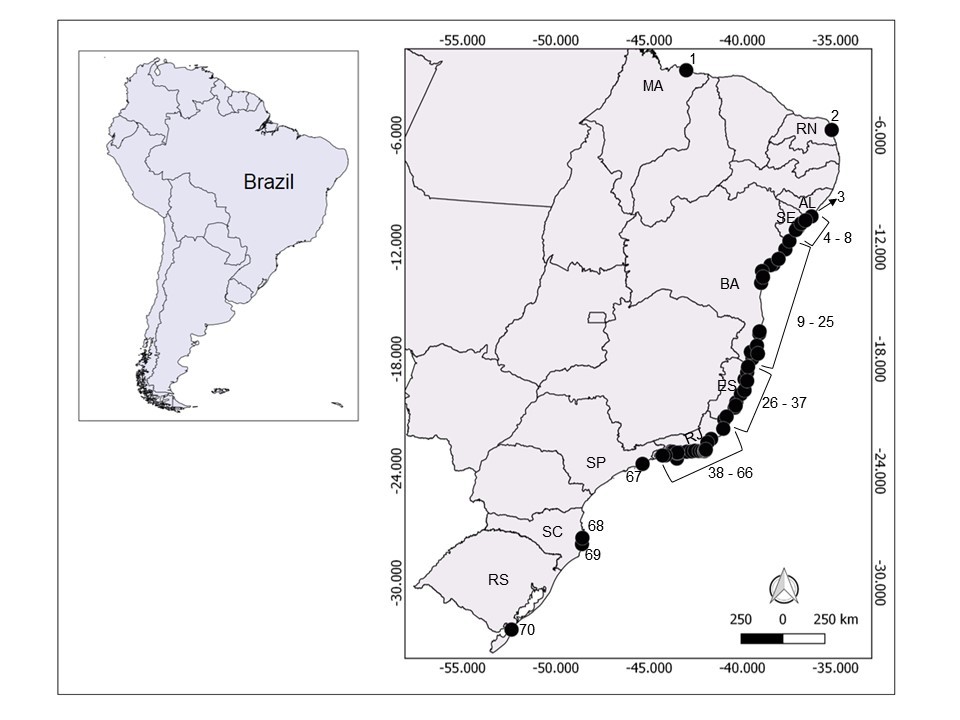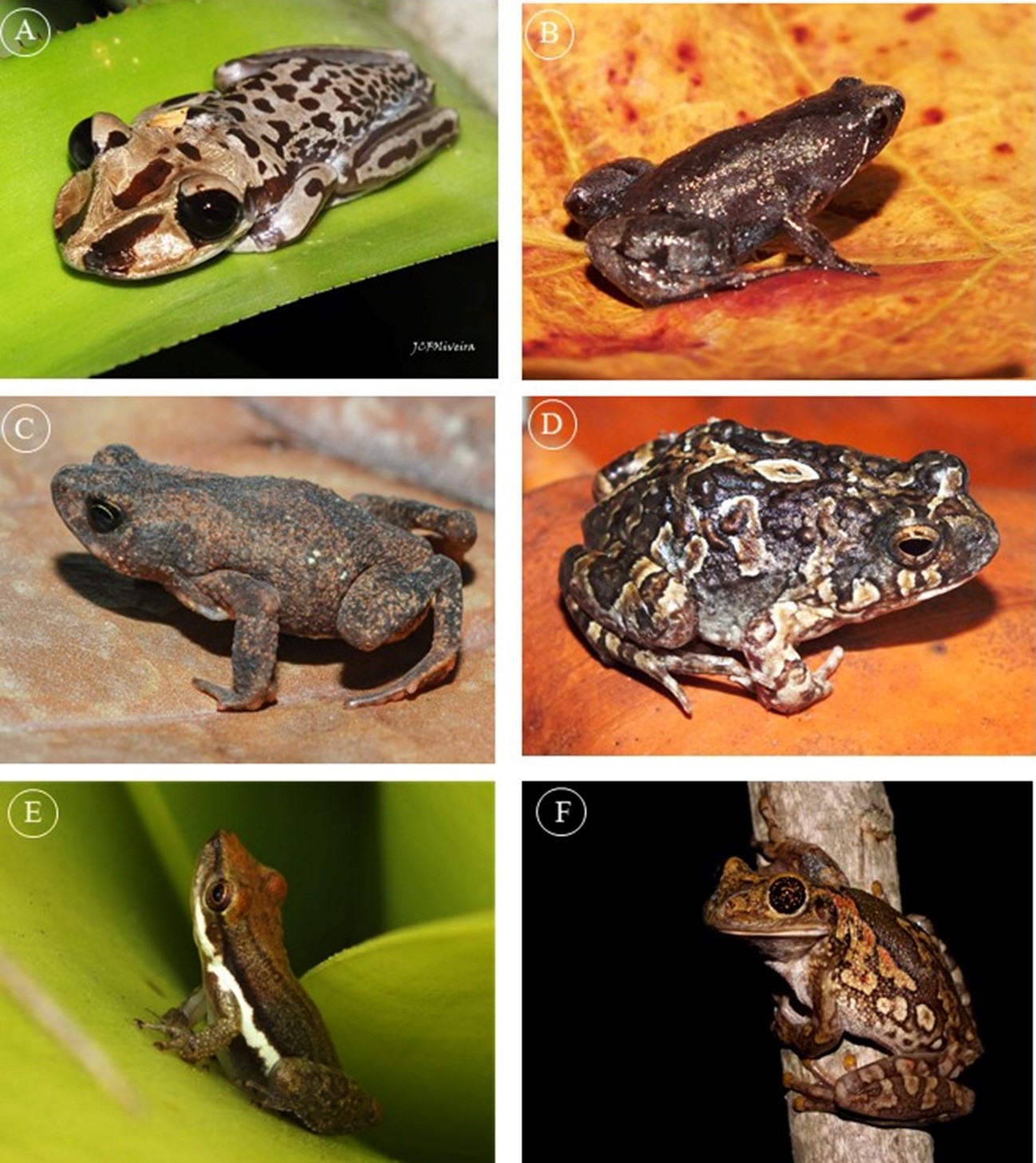|
TESTUDINES
|
|
|
|
|
|
Cheloniidae
|
|
|
|
|
|
Chelonia mydas (Linnaeus, 1758) |
EN |
VU |
BA: VU / SP: EN / RJ: VU / ES: VU / SC: VU |
-
|
|
|
|
|
|
|
Dermochelyidae
|
|
|
|
|
|
Dermochelys coriacea (Vandelli, 1761) |
VU |
CR |
ES: CR |
-
|
|
|
|
|
|
|
Emydidae
|
|
|
|
|
|
Trachemys dorbignyi (Duméril & Bibron, 1835) |
- |
NT |
|
-
|
|
Trachemys adiutrix Vanzolini, 1995 |
EN |
NT |
|
-
|
|
|
|
|
|
|
Geoemydidae
|
|
|
|
|
|
Rhinoclemmys sp. nov. |
-
|
-
|
|
-
|
|
|
|
|
|
|
CROCODYLIA
|
|
|
|
|
|
Alligatoridae
|
|
|
|
|
|
Caiman crocodilus (Linnaeus, 1758) |
LC |
LC |
|
-
|
|
Caiman latirostris (Daudin, 1802) |
|
|
RJ: EN / SP: VU |
|
|
|
|
|
|
|
Amphisbaenidae
|
|
|
|
|
|
Amphisbaena alba Linnaeus, 1758 |
-
|
LC |
|
-
|
|
Amphisbaena ibijara Rodrigues, Andrade & Lima, 2003 |
-
|
LC |
|
-
|
|
Amphisbaena nigricauda Gans, 1966 |
-
|
EN |
BA: EN |
E |
|
Amphisbaena pretrei Duméril & Bibron, 1839 |
-
|
LC |
|
-
|
|
Amphisbaena vermicularis Wagler in Spix, 1824 |
-
|
LC |
|
-
|
|
Leposternon microcephalum Wagler in Spix, 1824 |
-
|
LC |
|
-
|
|
|
|
|
|
|
SQUAMATA (lizards)
|
|
|
|
|
|
Anguidae
|
|
|
|
|
|
Ophiodes cf. striatus (Spix, 1825) |
-
|
- |
|
-
|
|
|
|
|
|
|
Polychrotidae
|
|
|
|
|
|
Polychrus marmoratus (Linnaeus, 1758) |
-
|
-
|
|
-
|
|
Polychrus acutirostris Spix, 1825 |
-
|
-
|
|
-
|
|
|
|
|
|
|
Teiidae
|
|
|
|
|
|
Ameivula ocellifera (Spix, 1825) |
-
|
-
|
|
-
|
|
Ameivula nativo (Rocha et al., 1997ROCHA, C.F.D., BERGALLO, H.G. and PECCININI-SEALE, D., 1997. Evidence of an unisexual population of the Brazilian whiptail lizard genus Cnemidophorus (Teiidae) with description of a new species. Herpetologica, vol. 53, no. 3, pp. 374-382.) |
-
|
EN |
BA: EN / ES: VU |
E |
|
Ameiva ameiva (Linnaeus, 1758) |
-
|
— |
|
-
|
|
Contomastix lacertoides (Duméril & Bibron, 1839) |
-
|
— |
SC: EN |
-
|
Glaucomastix abaetensis (Dias et al., 2002DIAS, E.J.R., ROCHA, C.F.D. and VRCIBRADIC, D., 2002. New Cnemidophorus (Squamata: Teiidae) from Bahia State, northeastern Brazil. Copeia, vol. 2002, no. 4, pp. 928-937. http://dx.doi.org/10.1643/0045-8511(2002)002[1070:NCSTFB]2.0.CO;2.
http://dx.doi.org/10.1643/0045-8511(2002...
) |
-
|
EN |
|
E |
|
Glaucomastix littoralis (Rocha, Araújo, Vrcibradic & Costa, 2000) |
-
|
EN |
|
E |
|
Kentropyx calcarata Spix, 1825 |
-
|
-
|
|
-
|
|
Salvator merianae Duméril & Bibron, 1839 |
-
|
-
|
|
-
|
|
Tupinambis teguixin (Linnaeus, 1758) |
-
|
-
|
|
-
|
|
|
|
|
|
|
Mabuyidae
|
|
|
|
|
|
Aspronema dorsivittatum (Cope, 1862) |
-
|
-
|
BA: EN |
-
|
|
Brasiliscincus agilis (Raddi, 1823) |
-
|
-
|
|
-
|
|
Brasiliscincus caissara (Rebouças-Spieker, 1974) |
-
|
EN |
SP: VU |
E |
|
Brasiliscincus heathi (Schmidt & Inger, 1951) |
-
|
-
|
|
-
|
|
Psychosaura macrorhyncha (Hoge, 1947) |
-
|
-
|
|
-
|
|
Psychosaura agmosticha (Rodrigues, 2000) |
-
|
-
|
|
-
|
|
Varzea bistriata (Spix, 1825) |
-
|
LC |
|
-
|
|
|
|
|
|
|
Tropiduridae
|
|
|
|
|
|
Tropidurus hispidus (Spix, 1825) |
-
|
-
|
|
-
|
|
Tropidurus hygomi Reinhardt & Luetken, 1861 |
-
|
-
|
BA: VU |
E |
|
Tropidurus torquatus (Wied, 1820) |
-
|
-
|
|
-
|
|
|
|
|
|
|
Sphaerodactylidae
|
|
|
|
|
|
Coleodactylus meridionalis (Boulenger, 1888) |
-
|
-
|
|
-
|
|
Gonatodes humeralis (Guichenot, 1855) |
-
|
-
|
|
-
|
|
|
|
|
|
|
Gymnophthalmidae
|
|
|
|
|
|
Colobosaura modesta (Reinhardt & Luetken, 1862) |
-
|
-
|
|
-
|
|
Dryadosaura nordestina Rodrigues, Freire, Pellegrino & Sites, 2005 |
LC |
-
|
BA: VU |
-
|
|
Ecpleopus gaudichaudii Duméril & Bibron, 1839 |
-
|
-
|
|
-
|
|
Leposoma annectans Ruibal, 1952 |
-
|
-
|
BA: VU |
-
|
|
Micrablepharus maximiliani (Reinhardt & Luetken, 1862) |
-
|
-
|
|
-
|
|
|
|
|
|
|
Gekkonidae
|
|
|
|
|
|
Hemidactylus mabouia (Moreau de Jonnès, 1818) |
-
|
-
|
|
-
|
|
|
|
|
|
|
Phyllodactylidae
|
|
|
|
|
|
Gymnodactylus darwinii (Gray, 1845) |
-
|
-
|
|
-
|
|
Phyllopezus lutzae (Loveridge, 1941) |
-
|
-
|
|
-
|
|
|
|
|
|
|
Iguanidae
|
|
|
|
|
|
Iguana iguana (Linnaeus, 1758) |
-
|
-
|
|
-
|
|
|
|
|
|
|
Leiosauridae
|
|
|
|
|
|
Enyalius bibronii Boulenger, 1885 |
LC |
-
|
|
-
|
|
|
|
|
|
|
Liolaemidae
|
|
|
RJ: VU |
|
|
Liolaemus lutzae Mertens, 1938 |
VU |
CR |
|
E |
|
Liolaemus occipitalis Boulenger, 1885 |
VU |
VU |
RS: VU/ SC: VU |
-
|
|
|
|
|
|
|
SQUAMATA (snakes)
|
|
|
|
|
|
Boidae
|
|
|
|
|
|
Boa constrictor constrictor (Linnaeus, 1758) |
-
|
-
|
|
-
|
|
Eunectes murinus (Linnaeus, 1758) |
-
|
-
|
|
-
|
|
|
|
|
|
|
Dipsadidae
|
|
|
|
|
|
Cercophis auratus (Schlegel, 1837) |
-
|
-
|
BA: VU / RS: EN / ES: DD |
-
|
|
Dipsas neuwiedi (Ihering, 1911) |
-
|
-
|
|
-
|
|
Erythrolamprus miliaris merremi (Wied, 1821) |
|
|
|
|
|
Erythrolamprus poecilogyrus poecilogyrus (Wied, 1824) |
-
|
-
|
|
-
|
|
Helicops angulatus (Linnaeus, 1758) |
-
|
-
|
|
-
|
|
Hydrodynastes gigas (Duméril, Bibron & Duméril, 1854) |
-
|
-
|
RS: VU |
-
|
|
Leptodeira annulata annulata (Linnaeus, 1758) |
-
|
-
|
|
-
|
|
Leptophis ahaetulla ahaetulla (Linnaeus, 1758) |
-
|
-
|
|
-
|
|
Leptophis ahaetulla liocercus (Wied, 1824) |
-
|
-
|
|
-
|
|
Lygophis meridionalis (Schenkel, 1901) |
-
|
-
|
|
-
|
|
Oxyrhopus petolarius (Linnaeus, 1758) |
|
|
|
|
|
Oxyrhopus rhombifer rhombifer Duméril, Bibron & Duméril, 1854 |
-
|
-
|
BA: EN |
-
|
|
Oxyrhopus trigeminus Duméril, Bibron & Duméril, 1854 |
-
|
-
|
|
-
|
|
Philodryas nattereri Steindachner, 1870 |
-
|
-
|
|
-
|
|
Philodryas olfersii (Liechtenstein, 1823) |
-
|
-
|
|
-
|
|
Philodryas patagoniensis (Girard, 1858) |
-
|
-
|
|
-
|
|
Phimophis guerini (Duméril, Bibron & Duméril, 1854) |
-
|
-
|
|
-
|
|
Pseudoboa nigra (Duméril, Bibron & Duméril, 1854) |
-
|
-
|
|
-
|
|
Psomophis joberti (Sauvage, 1884) |
-
|
-
|
|
-
|
|
Taeniophallus occipitalis (Jan, 1863) |
-
|
-
|
|
-
|
|
Thamnodynastes hypoconia (Cope, 1860) |
-
|
-
|
|
-
|
|
Thamnodynastes sp. |
|
|
|
|
|
Xenodon merremii (Wagler in Spix, 1824) |
-
|
-
|
|
-
|
|
|
|
|
|
|
Colubridae
|
|
|
|
|
|
Chironius bicarinatus (Wied, 1820) |
-
|
-
|
|
-
|
|
Chironius exoletus (Linnaeus, 1758) |
-
|
-
|
|
-
|
|
Chironius flavolineatus (Jan, 1863) |
-
|
-
|
|
-
|
|
Drymarchon corais (Boie, 1827) |
-
|
-
|
|
-
|
|
Mastigodryas bifossatus (Raddi, 1820) |
-
|
-
|
|
-
|
|
Oxybelis aeneus (Wagler in Spix, 1824) |
-
|
-
|
|
-
|
|
Oxybelis fulgidus (Daudin, 1803) |
-
|
-
|
|
-
|
|
Spilotes pullatus pullatus (Linnaeus, 1758) |
-
|
-
|
|
-
|
|
Tantilla melanocephala (Linnaeus, 1758) |
-
|
-
|
|
-
|
|
|
|
|
|
|
Typhlopidae
|
|
|
|
|
|
Amerotyphlops brongersmianus (Vanzolini, 1976) |
-
|
-
|
|
-
|
|
|
|
|
|
|
Elapidae
|
|
|
|
|
|
Micrurus corallinus (Merrem, 1820) |
-
|
-
|
|
-
|
|
Micrurus aff. ibiboboca (Merrem, 1820) |
-
|
DD |
|
-
|
|
Micrurus lemniscatus carvalhoi Roze, 1967 |
-
|
-
|
|
-
|
|
|
|
|
|
|
Viperidae
|
|
|
|
|
|
Bothrops leucurus Wagler in Spix, 1824 |
-
|
-
|
|
-
|

 Thumbnail
Thumbnail
 Thumbnail
Thumbnail
 Thumbnail
Thumbnail


